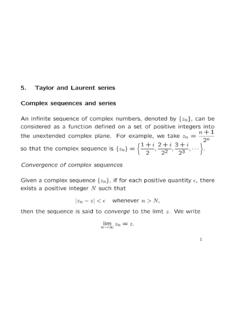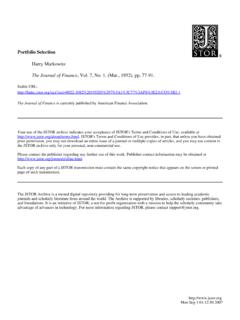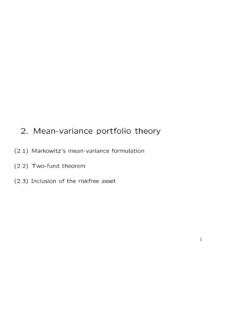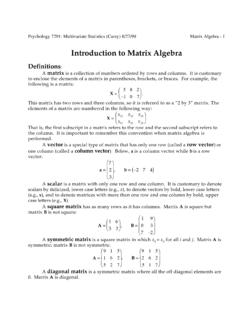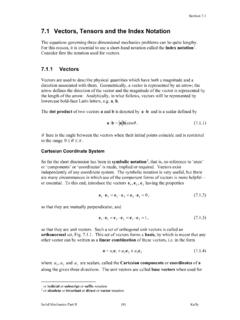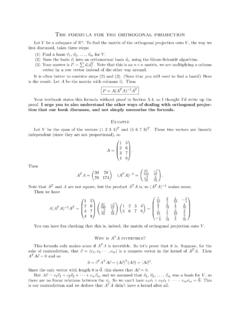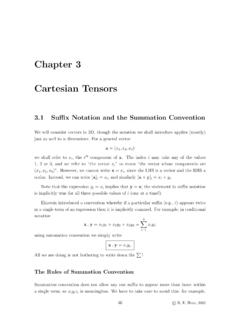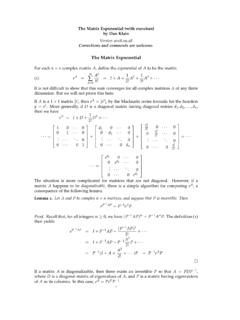Transcription of Inner Product Spaces and Orthogonality
1 Inner Product Spaces and Orthogonalityweek 13-14 Fall 20061 Dot Product ofRnTheinner productordot productofRnis a function , defined by u,v =a1b1+a2b2+ +anbnforu= [a1, a2, .. , an]T,v= [b1, b2, .. , bn]T Inner Product , satisfies the following properties:(1)Linearity: au+bv,w =a u,w +b v,w .(2)Symmetric Property: u,v = v,u .(3)Positive Definite Property: For anyu V, u,u 0; and u,u = 0 if and only ifu= the dot Product we have geometric concepts such as the length of a vector , the angle between twovectors, Orthogonality , etc. We shall push these concepts to abstract vector Spaces so that geometric conceptscan be applied to describe abstract Inner Product spacesDefinition productof a real vector spaceVis an assignment that for any two vectorsu, v V, there is a real number u,v , satisfying the following properties:(1)Linearity: au+bv,w =a u,w +b v,w.
2 (2)Symmetric Property: u,v = v,u .(3)Positive Definite Property: For anyu V, u,u 0; and u,u = 0 if and only ifu= vector spaceVwith an Inner Product is called a (real) Inner Product [x1x2],y=[y1y2] R2, define x,y = 2x1y1 x1y2 x2y1+ , is an Inner Product onR2. It is easy to see the linearity and the symmetric property. As for thepositive definite property, note that x,x = 2x21 2x1x2+ 5x22= (x1+x2)2+ (x1 2x2)2 , x,x = 0 if and only ifx+x2= 0, x1 2x2= 0,which impliesx1=x2= 0, ,x=0. This Inner Product onR2is different from the dot Product each vectoru V, thenorm(also called thelength) ofuis defined as the number u := u,u.
3 If u = 1, we calluaunit vectoranduis said to benormalized. For any nonzero vectorv V, wehave the unit vector v=1 v process is {u1,u2, .. ,un}be a basis of ann-dimensional Inner Product spaceV. For vectorsu,v V,writeu=x1u1+x2u2+ +xnun,v=y1u1+y2u2+ + linearity implies u,v = n i=1xiui,n j=1yjuj =n i=1n j=1xiyj ui,uj .We call then nmatrixA= u1,u1 u1,u2 u1,un u2,u1 u2,u2 u2,un .. un,u1 un,u2 un,un thematrix of the Inner Product , relative to the basisB. Thus, using coordinate vectors[u]B= [x1, x2, .. , xn]T,[v]B= [y1, y2, .. , yn]T,we have u,v = [u]TBA[v] Examples of Inner Product spacesExample vector spaceRnwith the dot productu v=a1b1+a2b2+ +anbn,whereu= [a1, a2.]
4 , an]T,v= [b1, b2, .. , bn]T Rn, is an Inner Product space. The vector spaceRnwiththis special Inner Product (dot Product ) is called theEuclideann-space, and the dot Product is called thestandard Inner vector spaceC[a, b] of all real-valued continuous functions on a closed interval [a, b] isan Inner Product space, whose Inner Product is defined by f, g = baf(t)g(t)dt, f, g C[a, b].Example vector spaceMm,nof allm nreal matrices can be made into an Inner Product spaceunder the Inner Product A, B = tr(BTA),whereA, B Mm, instance, whenm= 3, n= 2, and forA= a11a12a21a22a31a32 , B= b11b12b21b22b31b32 ,we haveBTA=[b11a11+b21a21+b31a31b11a12+b21a 22+b31a32b12a11+b22a21+b32a31b12a12+b22a 22+b32a32].
5 Thus A, B =b11a11+b21a21+b31a31+b12a12+b22a22+b32a 32=3 i=13 j= means that the Inner Product space(M3,2, , )isisomorphicto the Euclidean space(R3 2, ).4 Representation of Inner productTheorem ann-dimensional vector space with an Inner Product , , and letAbe the matrixof , relative to a basisB. Then for any vectorsu,v V, u,v = the coordinate vectors ofuandv, respectively, ,x= [u]Bandy= [v] the Inner Product ofR3defined by x,y = 2x1y1 x1y2 x2y1+ 5x2y2,wherex=[x1x2],y=[y1y2] R2, its matrix relative to the standard basisE={e1,e2}isA=[ e1,e1 e1,e2 e2,e1 e2,e2 ]=[2 1 1 5].The Inner Product can be written as x,y =xTAy= [x1, x2][2 1 1 5][y1y2].
6 We may change variables so the the Inner Product takes a simple form. For instance, let{x1= (2/3)x 1+ (1/3)x 2x2= (1/3)x 1 (1/3)x 2,{y1= (2/3)y 1+ (1/3)y 2y2= (1/3)y 1 (1/3)y have x,y = 2(23x 1+13x 2)(23y 1+13y 2) (23x 1+13x 2)(13y 1 13y 2) (13x 1 13x 2)(13y 1 13y 2)+5(13x 1 13x 2)(13y 1 13y 2)=x 1y 1+x 2y 2=x Ty .3 This is equivalent to choosing a new basis so that the matrix of the Inner Product relative to the new basisis the identity fact, the matrix of the Inner Product relative to the basisB={u1=[2/31/3],u2=[1/3 1/3]}is the identity matrix, ,[ u1,u1 u2,u1 u1,u2 u2,u2 ]=[1 00 1]LetPbe the transition matrix from the standard basis{e1,e2}to the basis{u1,u2}, ,[u1,u2] = [e1,e2]P= [e1,e2][2/3 1/31/3 1/3].}}
7 Letx be the coordinate vector of the vectorxrelative the basisB. (The coordinate vector ofxrelative tothe standard basis is itselfx.) Thenx= [e1,e2]x= [u1,u2]x = [e1,e2]Px .It follows thatx=Px .Similarly, lety be the coordinate vector ofyrelative toB. Theny=Py .Note thatxT=x TPT. Thus, on the one hand by Theorem, x,y =x TIny =x Ty .On the other hand, x,y =xTAy=x TPTAPy .Theorem a finite-dimensional Inner Product space. LetA, Bbe matrices of the Inner productrelative to basesB,B ofV, respectively. IfPis the transition matrix fromBtoB . ThenB= Cauchy-Schwarz inequalityTheorem (Cauchy-Schwarz Inequality).
8 For any vectorsu,vin an Inner Product spaceV, u,v 2 u,u v,v .Equivalently, u,v u v . the functiony=y(t) := u+tv,u+tv , t (t) 0 by the third property of Inner Product . Note thaty(t) is a quadratic function oft. In fact,y(t) = u,u+tv + tv,u+tv = u,u + 2 u,v t+ v,v the quadratic equation u,u + 2 u,v t+ v,v t2= 0has at most one solution asy(t) 0. This implies that its discriminant must be less or equal to zero, ,(2 u,v )2 4 u,u v,v Cauchy-Schwarz inequality norm in an Inner Product spaceVsatisfies the following properties:(N1) v 0; and v = 0if and only ifv= 0.(N2) cv =|c| v .(N3) u+v u + v.
9 For nonzero vectorsu,v V, the Cauchy-Schwarz inequality implies 1 u,v u v betweenuandvis defined bycos = u,v u v .The angle exists and is OrthogonalityLetVbe an Inner Product space. Two vectorsu,v Vare said to beorthogonalif u,v = Inner Product spaceC[ , ], the functions sintand costare orthogonal as sint,cost = sintcostdt=12sin2t = 0 0 = [a1, a2, .. , an]T Rn. The set of all vector of the Euclideann-spaceRnthat areorthogonal touis a subspace ofRn. In fact, it is the solution space of the single linear equation u,x =a1x1+a2x2+ +anxn= [1,2,3,4,5]T,v= [2,3,4,5,6]T, andw= [1,2,3,3,2]T R5.
10 The set of all vectorsofR5that are orthogonal tou,v,wis a subspace ofR5. In fact, it is the solution space of the linear system x1+ 2x2+ 3x3+ 4x4+ 5x5= 02x1+ 3x2+ 4x3+ 5x4+ 6x5= 0x1+ 2x2+ 3x3+ 3x4+ 2x5= 0 LetSbe a nonempty subset of an Inner Product spaceV. We denote byS the set of all vectors ofVthat are orthogonal to every vector ofS, called theorthogonal complementofSinV. In notation,S :={v V v,u = 0 for allu S}.IfScontains only one vectoru, we writeu ={v V v,u = 0}.Proposition a nonempty subset of an Inner Product spaceV. Then the orthogonal complementS is a subspace show thatS is a subspace.

